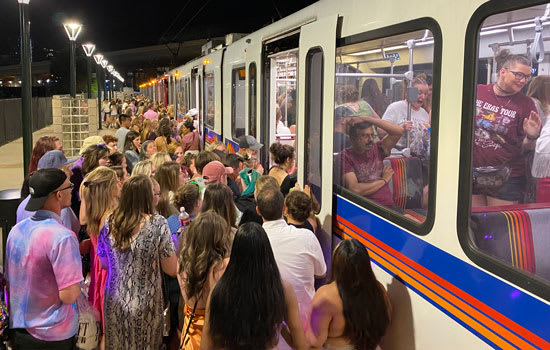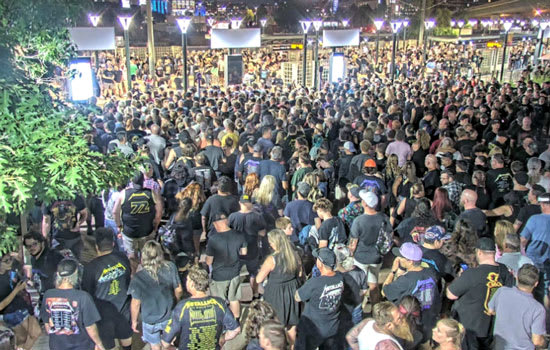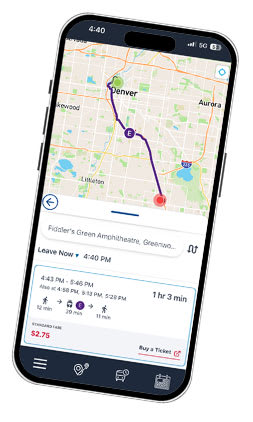
High-Volume Events
Connecting customers to concerts, games, festivals, and other metro area activitiesOn this page:
- What is a high-volume event?
- Learn how RTD prepares for events and deploys service
- Discover agency resources to support customers
- See maps of bus routes and rail lines that serve transit-adjacent venues
- Read about a Board-adopted resolution to create a comprehensive plan focused on dedicated service
- Share ideas and provide feedback about RTD's event services
- Understand key terms and definitions

Every year, hundreds of high-volume events and activities – from concerts and sporting games to festivals and shows – take place around the Denver metro area. Millions of Coloradans and visitors attend these events, and RTD wants to have a leading role in supporting access, mobility, and attendance. Whether it’s getting fans to the big game, music lovers to a much-anticipated concert, or families to seasonal celebration, RTD’s mission is to make lives better through connections.
In looking ahead to the future, the agency is exploring ways to improve its services while building upon existing successes. We want to be your first choice when planning a trip to and from an event.
What is a high-volume event?
High-volume events are activities that attract a large number of attendees within a concentrated area and timeframe. This surge in people results in an increased demand for transportation and requires effective crowd management. High-volume events can include concerts, sporting games, festivals, parades, and other major activities that significantly impact travel patterns and necessitate coordinated, pre-planning efforts and operational plans.
Pre-Planning Efforts
When preparing for high-volume events, RTD takes several operational factors into consideration. From the start and end times of events and the expected number of attendees to the venue’s location and infrastructure constraints, the agency uses several factors to determine the number of staff and transit vehicles required to deliver service. RTD also regularly monitors several metro area calendars and venue schedules to flag events that are slated to take place near bus stops and rail stations. Staff then compiles a multi-month lookahead calendar to develop event-specific operational plans.
At RTD, supplemental service for high-volume events refers to additional transit trips or vehicles deployed to meet increased customer demand. These operational plans build on RTD’s regular service levels, with the extent of supplemental services determined by available staff and resources. Based on anticipated crowd sizes and transit usage, RTD may lengthen trains, stage extra vehicles for quick deployment, dispatch support staff to manage crowds, add signage and temporary barriers to assist with queuing, and employ a range of communication tactics to keep customers informed.
RTD considers several operational factors when preparing for high-volume events:
- The start and end times
- The venue's proximity to transit stops and stations
- Simultaneous events occurring across the metro area
- Anticipated attendance
- Number of staff and transit vehicles required
- Infrastructure constraints (e.g., station size and rail signal and power)
Service Delivery
The agency also uses virtual platform monitoring to survey crowd sizes and make operational adjustments before and after high-volume events. RTD’s Light Rail Control relies on live camera feeds from across the system to identify crowd surges, allowing staff to make real-time decisions based on demand and dispatch trains to specific platforms. The virtual monitoring also enables control center staff to see when a rail platform has been completely cleared of all customers following an event.
RTD's Service Delivery Objectives
- Provide Safe and Secure Operations
- Preserve Base Service
- Deliver on the Customer Experience
- Meet Increased Customer Demand
- Support Community Needs
- Provide Clear Communications

Customer Support
RTD provides several tools and resources to assist customers attending high-volume events in the Denver metro area. In addition to friendly and helpful operators and on-site staff, here's a list of five tips:
- Plan ahead, be patient, and prepare for large crowds
- Sign up for Service Alerts
- Check RTD's website for bus and rail schedules
- Download the RTD Transit Watch app to report any safety or security issues
- Customer Care agents are available seven days a week by calling 303.299.6000
Special Destination Terms
In 2023, RTD also launched “special destination terms” as a trip planning resource for customers. The event-specific terms are available in the Next Ride app and eliminate the need to know a venue’s name or address. Customers can simply enter the name of the artist, band, sports team, or other event-related term as their destination. RTD’s trip planning application will then route the customer to the event’s venue from their current destination in the Denver metro area.
Special destinations initially launched prior to the back-to-back Taylor Swift concerts at Empower Field at Mile High Arena. That weekend, more than 150,000 trip itineraries were planned using special destination terms. In December 2024, RTD integrated JamBase, a live music data provider, into the Next Ride app. The integration automatically feeds concerts into the trip planning tool.

Transit-Adjacent Venues
Empower Field at Mile High Stadium
Capacity: 75,000
Annual Events: +/- 25
August 2025 Service Change
Rail: D, E, and W
Bus: 15L, 16, 20, 30, and 31
*Please check RTD's Next Ride app for a full schedule of services.
Ball Arena
Capacity: 20,000
Annual Events: +/- 100
August 2025 Service Change
Rail: D, E, and W
Bus: 1, 6, 15L, 20, and 43
*Please check RTD's Next Ride app for a full schedule of services.
Colorado Convention Center
Capacity: 20,000+
Annual Events: +/- 400
August 2025 Service Change
Rail: Temporarily suspended due to maintenance
Bus: 0, 6, 8, 9, 10, 15, 15L, 16, 19, 28, 32, 38, 43, 44, 48, 52, ART, and FreeRide
*Please check RTD's Next Ride app for a full schedule of services.
Denver Center for the Performing Arts
Capacity: 2,500
Annual Events: +/- 250
August 2025 Service Change
Rail: Temporarily suspended due to maintenance
Bus: 0, 6, 8, 9, 10, 15, 15L, 16, 19, 28, 32, 38, 43, 44, 48, 52, ART, and FreeRide
*Please check RTD's Next Ride app for a full schedule of services.
Coors Field
Capacity: 50,000
Annual Events: +/- 100
August 2025 Service Change
Rail: A, B, D, E, G, N, and W
Bus: 0, 8, 9, 15, 20, 38, 48, 52, FF4, ART, and FreeRide, and Free MetroRide
VENUE MAP COMING SOON
*Please check RTD's Next Ride app for a full schedule of services.
National Western Complex
Capacity: 10,000
Annual Events: +/- 200
August 2025 Service Change
Rail: N
Bus: 48
VENUE MAP COMING SOON
*Please check RTD's Next Ride app for a full schedule of services.
Fiddler's Green Amphitheatre
Capacity: 18,000
Annual Events: +/- 25
August 2025 Service Change
Rail: E and R
Bus: 66, 153, 169, and AT
VENUE MAP COMING SOON
*Please check RTD's Next Ride app for a full schedule of services.
Board Resolution
On October 28, 2025, RTD's Board adopted a resolution focused on enhancing high-volume event services. The resolution outlines several requirements for creating the plan, including the necessary staffing levels and financial resources, revenue projection estimates, sponsorship opportunities, and a marketing strategy. The plan must also adhere to all federal regulations and requirements. Work on creating the plan has commenced, and the full plan will be shared with RTD’s Board in February 2026.
The Board anticipates taking action related to the details of the comprehensive plan in March, and if adopted, any approved operational adjustments or service level increases would begin in May 2026.
Read the Board ResolutionShare Ideas and Provide Feedback
Key Terms and Definitions
Base Service
Regularly scheduled bus and rail services
Supplemental Service
Additional transit trips or vehicles beyond base service to meet increased customer demand during high-volume events
Crowd Management
Actions to ensure the safe and secure movement of customers at stations, stops, and transit vehicles during high-volume events
Impact Team
Employees who are trained and volunteer their time to assist customers during large-scale events, planned and unplanned disruptions, and peak service times
Train Consist
A train, one or more rail vehicles operated as a train
Married Pair
Two rail vehicles permanently or semi-permanently coupled, sharing equipment and operated together
Max Load
Maximum customers in a transit vehicle
Bus:

Light Rail:

Commuter Rail:

After-Action Review
A structured evaluation to analyze operations, evaluate performance, and assess communications, with the goal of improving future transit service delivery